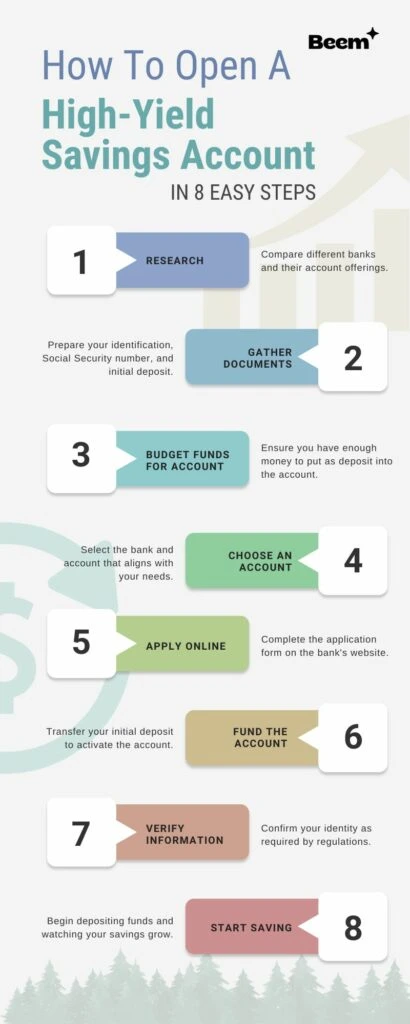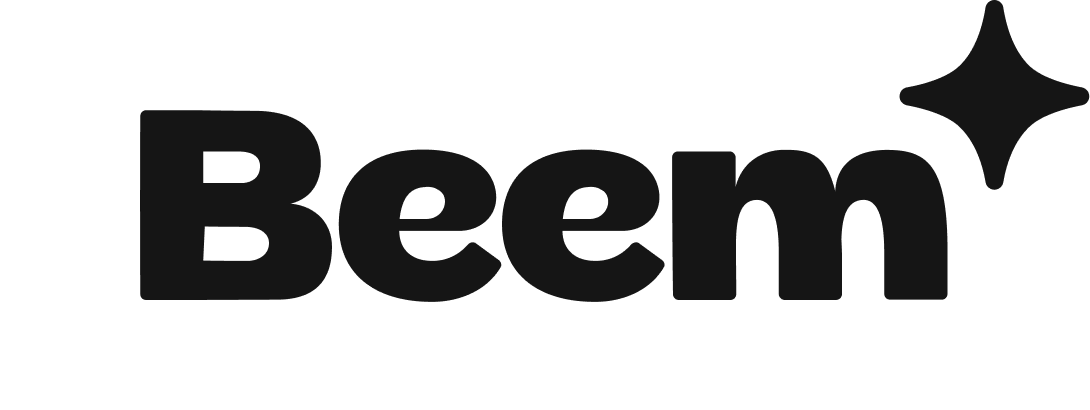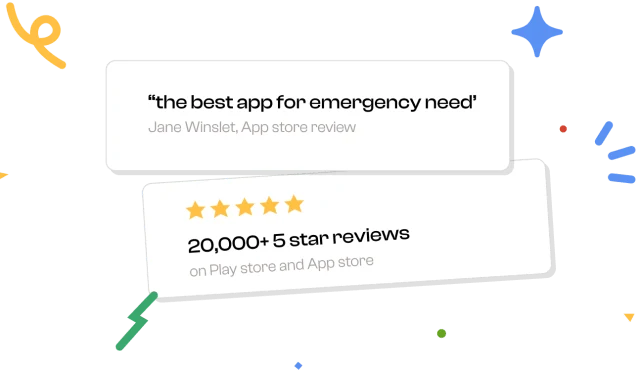High-yield savings accounts have emerged as a popular choice for anyone looking to grow their money with minimal risk. This comprehensive guide will give you all the information you need about high-yield savings accounts, explaining what they are, why they’re beneficial, how they work, and how you can choose the best high-yield savings account for your financial goals.
Check out the Beem app to get updated interest rates and compare the latest best high-yield savings accounts that align with your savings goals and priorities.
What is a High-Yield Savings Account?
A high-yield savings account is a type of savings account offered by banks and financial institutions that offers a higher interest rate than traditional savings accounts. The term “high-yield” refers to the higher interest rates these accounts provide, allowing account holders to earn more on their deposits. High-yield savings accounts are specialized financial products offered by banks and credit unions. Unlike traditional savings accounts that offer minimal interest, high-yield savings accounts provide significantly higher interest rates, allowing your savings to grow faster. Online banks typically offer these accounts, although some traditional brick-and-mortar banks also provide them.
People Also Read – Do High-Yield Savings Account Rates Change?
Why Go for a High-Yield Savings Account?
High-yield savings accounts provide several compelling reasons to consider them for your savings strategy. First and foremost, the higher interest rates mean your money can grow faster over time. Additionally, these accounts often come with minimal fees and provide easy access to funds, making them a flexible option for emergencies or planned expenses.
Competitive Interest Rates
One of the most compelling benefits of high yield savings accounts is their higher interest rates. These rates can be several times higher than those of traditional savings accounts, allowing your savings to grow quickly over time.
Safety and Security
High-yield savings accounts are used for safety and security. They are typically offered by reputable financial institutions insured by the Federal Deposit Insurance Corporation (FDIC) or the National Credit Union Administration (NCUA). This means that even if the bank were to face financial difficulties, your deposits would be protected up to a specific limit.
Flexibility and Accessibility
Despite the higher interest rates, high-yield savings accounts maintain a level of accessibility and flexibility similar to traditional savings accounts. You can easily withdraw your funds when needed, either through electronic transfers, ATM withdrawals, or, in some cases, checks.
How Much Does a High-Yield Savings Account Earn?
A high-yield savings account is designed to give customers a higher interest rate than traditional savings accounts. This elevated interest rate is a critical factor that sets high-yield savings accounts apart and makes them an attractive option for individuals looking to grow their savings more effectively.
The exact amount a high-yield savings account can earn varies. This is based on several factors, including the interest rate, compounding frequency, initial deposit, and the time the money remains in the account. Generally, high-yield savings accounts offer annual percentage yields (APYs) that are notably higher than the average interest rates of traditional savings accounts.
Interest in a high-yield savings account is typically compounded, meaning that you earn interest not only on your initial deposit but also on the accumulated interest. This compounding effect contributes significantly to the growth of your savings over time. It’s important to note that the frequency of compounding, whether daily, monthly, or annually, will impact the final earnings.
The Earning Potential of a HYSA
For instance, consider a hypothetical scenario: You deposit $10,000 into a high-yield savings account with an APY of 2.5% that compounds interest monthly. Over a year, the compounding effect would lead to earnings of approximately $253.82, resulting in a total account balance of around $10,253.82 by the end of the year. However, if the interest were compounded annually, the total earnings would be slightly lower due to less frequent compounding.
Remember that interest rates can vary from one bank to another and are subject to change based on economic conditions. It’s advisable to regularly monitor your account’s interest rate to ensure you are still getting the best return on your savings.
A high-yield savings account has the potential to earn you more money compared to a traditional savings account due to its higher interest rates and compounding effect. By taking advantage of the compounding nature of these accounts, you can watch your savings grow over time. Conducting research, comparing rates, and choosing an account that aligns with your financial goals and needs is always recommended.

How to Choose the Best High-Yield Savings Account?
Selecting the best high-yield savings account involves carefully considering various factors to ensure that the account aligns with your financial goals and preferences. Here’s a detailed guide on how to choose the best high-yield savings account:
Compare Interest Rates and APY:
Start by comparing the interest rates and Annual Percentage Yields (APYs) that different banks offer. The APY considers compounding, providing a more accurate representation of how your savings will grow over time. Opt for an account with a competitive interest rate to maximize your earnings.
Consider Minimum Balance Requirements:
Some high-yield savings accounts require a minimum balance to open and maintain the account. Evaluate whether you can comfortably meet the minimum balance requirement without affecting your financial stability.
Evaluate Fees and Charges:
Be aware of any fees associated with the account. Standard fees include monthly maintenance fees, excessive withdrawal fees, and charges for falling below the minimum balance. Choose an account with minimal fees or fee waivers based on specific criteria.
Check for Accessibility:
Consider the accessibility of the account. Ensure you can easily access your funds when needed, whether through online transfers, ATM withdrawals, or other methods. Look for an account that offers the convenience you require.
Review Online and Mobile Banking Features:
Since online banks offer many high-yield savings accounts, assess the quality of their online and mobile banking platforms. A user-friendly interface, mobile app, and responsive customer support can enhance your banking experience.
Research Bank Reputation:
Research the reputation and credibility of the bank offering the high-yield savings account. Ensure that the bank is insured by the Federal Deposit Insurance Corporation (FDIC) or the National Credit Union Administration (NCUA) to safeguard your deposits.
Consider Additional Features:
Some high-yield savings accounts come with additional features such as linked checking accounts, budgeting tools, and goal-setting features. Evaluate these features to check if they align with your financial needs.
Read Customer Reviews:
Read reviews from existing customers to gain insights into their experiences with the bank and the high-yield savings account. Positive reviews can indicate good customer service and a reliable banking relationship.
Assess Customer Support:
Test the customer support channels provided by the bank. Quick and responsive customer service can be crucial if you encounter issues or have questions about your account.
Compare with Other Savings Options:
Consider how a high-yield savings account compares to other savings options like traditional savings accounts, certificates of deposit (CDs), and money market accounts. Assess the pros and cons of each option before making a decision.
Check for Additional Benefits:
Some high-yield savings accounts offer perks such as ATM fee reimbursements, free checks, and rewards programs. Evaluate these additional benefits to see if they add value to your banking experience.
Read the Fine Print:
Before finalizing your decision, carefully read the terms and conditions of the account agreement. Understand the account’s features, restrictions, and any potential interest rate or fee changes.
By taking these steps, you can make an informed decision when choosing the best high-yield savings account for your financial needs. Remember that the correct account can help you achieve your savings goals while providing convenient access to your funds.
List of 10 Best high-yield Savings Accounts:
These high-yield savings accounts exemplify the potential for significant growth in your savings by offering elevated interest rates. When considering these options, consider other factors such as minimum balance requirements, fees, online banking features, and customer service quality. Choosing the proper high-yield savings account from this list can help you effectively achieve your financial goals while ensuring your money is secure and accessible. Here is a list of the 10 best high-yield savings accounts as of August 2023:
| Bank | APY | Minimum Opening Deposit | Minimum Balance Requirement | Monthly Fee | ATM Card |
| Milli* | 5.25% | Any amount | Any amount | None | Yes |
| Newtek Bank | 5.25% | $0 | Any amount | None | No |
| UFB Direct | 5.25% | None | None | None | Yes |
| Evergreen Bank Group | 5.25% | $100 | Any amount | None | Yes |
| TotalDirectBank | 5.20% | $25,000 | $2,500 to earn stated APY | None | No |
| CFG Bank | 5.17% | $1,000 | $1,000 to earn stated APY | None | No |
| FNBO Direct | 5.15% | $1 | Any amount | None | Yes |
| Vio Bank | 5.15% | $100 | None | None | No |
| Popular Direct | 5.15% | $100 | None | None | No |
| Western State Bank | 5.15% | $5,000 | None | None | No |
| CIT Bank | 5.05% | $100 | $5,000 to earn stated APY | None | No |
| BankPurely | 5.05% | None | $25,000 to earn interest | None | Yes |
| iGObanking | 5.05% | $25,000 | $25,000 to earn interest | None | No |
| TAB Bank | 5.02% | Any amount | One penny | None | No |
| Salem Five Direct | 5.01% | $10 | Any amount | None | No |
Advantages and Disadvantages of high-yield Savings Account:
Advantages of High-Yield Savings Accounts:
Higher Interest Rates:
One of the primary advantages of high-yield savings accounts is their significantly higher interest rates than traditional savings accounts. This means your money can grow faster, helping you reach your savings goals more quickly.
Compounding Effect:
High-yield savings accounts typically offer compound interest, where you earn interest not only on your initial deposit but also on the accumulated interest. This compounding effect can generate exponential growth of your savings over time.
Safety and Security:
Most high-yield savings accounts are offered by reputable banks insured by the FDIC or NCUA, ensuring that your deposits are protected up to certain limits. This level of safety and security provides peace of mind for savers.
Accessibility and Liquidity:
Despite the higher interest rates, high-yield savings accounts maintain accessibility. You can access your funds through electronic transfers, ATM withdrawals, and checks.
No Investment Risk:
Unlike investing in the stock market or other investment vehicles, high-yield savings accounts have minimal risk. Your principal is secure, and your earnings are predictable, making these accounts suitable for risk-averse individuals.
Easy Account Management:
Many high-yield savings accounts are offered by online banks, providing convenient account management through user-friendly websites and mobile apps. This makes it easy to monitor and manage your savings.

Disadvantages of High-Yield Savings Accounts:
Lower Returns Compared to Investments:
While high-yield savings accounts offer higher interest rates than traditional savings accounts, they still provide lower returns compared to more aggressive investments like stocks or bonds. If your goal is substantial long-term growth, other investment options might be more suitable.
Limited Interest Earnings:
Despite the higher rates, the interest earned from high-yield savings accounts might not be sufficient to keep up with inflation, potentially leading to a decrease in your purchasing power over time.
Potential Fees:
Some high-yield savings accounts have fees associated with them, such as monthly maintenance fees or excessive withdrawal fees. It’s essential to read the account terms and conditions to understand any potential costs.
Minimum Balance Requirements:
Certain high-yield savings accounts require a minimum balance to open and maintain the account. You must meet these requirements to avoid fees or a change in your interest rate.
Opportunity Cost:
By focusing on a high-yield savings account, you may miss out on higher returns from other investment opportunities that carry more risk but offer more significant growth potential.
Limited Transactions:
Federal regulations often limit the number of certain types of withdrawals or transfers you can make from savings accounts. If you exceed these limits, you might face fees or restrictions.
High-yield savings accounts offer compelling advantages, such as higher interest rates and safety. However, they also come with limitations, including lower returns compared to investments and potential fees. Before choosing a high-yield savings account, assess your financial goals, risk tolerance, and the specific terms of the account to determine if it aligns with your overall financial strategy.
Factors to Consider When Choosing a High-Yield Savings Account
Interest Rates and APY
When comparing high-yield savings accounts, pay close attention to the interest rates and the Annual Percentage Yield (APY) offered. The APY takes into account compounding, giving you a more accurate picture of how much your savings will grow over time.
Minimum Balance Requirements
Some high-yield savings accounts require a minimum balance to open and maintain the account. Pick an account with a minimum balance requirement that meets your financial situation.
Fees and Charges
Be aware of any fees associated with the high-yield savings account. These might include monthly maintenance fees, excessive withdrawal fees, or fees for falling below the minimum balance.
Online and Mobile Banking Experience
Since most high-yield savings accounts are offered by online banks, it’s essential to assess the online and mobile banking experience. Look for user-friendly interfaces, mobile apps, and convenient customer support options.

How to Open a High-Yield Savings Account:
Opening a high-yield savings account is a straightforward process, but there are several steps you should take to ensure a smooth and informed experience. Here’s a detailed guide on how to open a high-yield savings account:
1. Research and Compare:
Start by researching different banks and financial institutions that offer high-yield savings accounts. Compare their interest rates, fees, minimum balance requirements, and any additional features they provide.
2. Choose the Right Bank:
Select a bank that aligns with your financial goals and preferences. Consider factors such as the bank’s reputation, customer service, online banking features, and accessibility.
3. Gather Required Documents:
Before you begin the application process, gather the necessary documents. These may include your Social Security number, government-issued identification (such as a driver’s license), and contact information.
4. Visit the Bank’s Website:
Most banks allow you to open a high-yield savings account online. Visit the bank’s official website and navigate to the section dedicated to account opening.
5. Start the Application:
Initiate the account opening process by clicking on the “Open an Account” or similar button. You’ll likely be asked to provide your personal information and create login credentials.
6. Choose the Account Type:
Select the type of high-yield savings account you want to open. Some banks offer multiple options, each with distinct features.
7. Complete the Application Form:
Fill out the application form with accurate and up-to-date information. You’ll need to provide details like your name, address, date of birth, and employment information.
8. Provide Identification:
Upload or input your identification documents as required by the bank. This might include scanning or photographing your driver’s license or passport.
9. Fund the Account:
To activate your high-yield savings account, you’ll need to fund it. Most banks allow you to fund the account electronically through a transfer from an existing bank account.
10. Review and Confirm:
Before finalizing your application, carefully review all the provided information. Make sure everything is accurate, and double-check the terms and conditions of the account.
11. Accept the Terms:
Read and agree to the terms and conditions of the high-yield savings account. This includes understanding any fees, withdrawal limits, and account policies.
12. Verify Identity:
Some banks may require you to verify your identity. This might involve answering security questions or providing additional documentation.
13. Await Approval:
Once you submit your application, the bank will review your information. Approval can take a few business days, during which the bank may conduct identity verification checks.
14. Receive Account Information:
Upon approval, you’ll receive an email or notification with your account details, including your account number and instructions for accessing online banking.
15. Start Managing Your Account:
Log in to your online banking portal using the provided credentials. From there, you can manage your high-yield savings account, set up transfers, and monitor your balance and interest earnings.
By following these steps, you can successfully open a high-yield savings account and start making the most of its benefits. Keep your account information secure, and regularly review your account to ensure it continues to meet your financial needs.
What to Do If You Can’t Open a High-Interest Savings Account
If you’re struggling to open a high-yield savings account due to a low credit score, consider a credit builder account. These accounts allow you to save money while simultaneously building or repairing your credit. As you make regular deposits, your positive payment behavior is reported to credit bureaus, helping you improve your creditworthiness over time. Here’s an in-depth look at what to do if you can’t open a high-interest savings account and how a credit-builder account can be a valuable solution:
1. Understand the Limitations:
If you’re facing challenges in opening a high-interest savings account, it’s essential to understand the reasons behind it. Common factors include a lack of credit history, poor credit score, or financial instability.
2. Explore Credit Builder Accounts:
A credit builder account is a financial tool designed to help individuals build or repair their credit. Unlike a traditional savings account, the primary goal of a credit-builder account is to improve your credit profile over time.
3. How Credit Builder Accounts Work:
With a credit-builder account, you deposit a certain amount of money into a locked account. This deposit serves as collateral for a small loan that you’ll make payments on over a predetermined period, typically six to twelve months. As you make these payments on time, they are reported to the credit bureaus, contributing positively to your credit history.
4. Benefits of Credit Builder Accounts:
- Credit Building: Regular payments on the credit builder account help establish a positive credit history, which is crucial for obtaining favorable loan terms in the future.
- Savings Component: While the primary goal is credit improvement, you’ll also be saving money during the account’s term.
- Low Risk: Since you’re essentially borrowing from yourself, credit builder accounts carry lower risks than traditional loans.
5. Find a Reputable Provider:
Research and select a reputable financial institution that offers credit builder accounts. Ensure they report your payments to all three major credit bureaus to maximize the positive impact on your credit score.
6. Plan for Monthly Payments:
When you open a credit-builder account, you’ll need to make regular monthly payments on the loan associated with the account. These payments are typically fixed and manageable.
7. Monitor Your Progress:
Keep track of your credit score and credit reports to see how your credit builder account is positively impacting your credit history. As you make consistent payments, you’ll likely observe an improvement in your credit profile.
8. Transition to Traditional Banking Products:
After successfully building or repairing your credit with a credit-builder account, you’ll be better positioned to apply for a high-interest savings account or other traditional banking products. Improved credit can also lead to more favorable interest rates on loans and credit cards.
9. Seek Financial Counseling:
If you’re struggling with credit issues or financial instability, consider seeking financial counseling from reputable sources. They can offer personalized guidance and strategies to improve your overall financial situation.
If you can’t open a high-interest savings account due to credit-related challenges, a credit-builder account is an excellent alternative. It not only helps you build or repair your credit but also fosters a savings habit. By responsibly managing a credit-builder account, you can eventually enhance your credit profile and gain access to more comprehensive banking options in the future. Alternatively, you can get $20-$1,000 for emergencies with Beem’s EverdraftTM at no credit checks, zero interest, no income restrictions, and no due dates.
Are high-yield Savings Accounts Safe?
Yes, high-yield savings accounts are generally considered safe financial instruments, offering individuals a secure place to store their money while earning competitive interest rates. Accounts offered by FDIC-insured banks are insured up to $250,000 per depositor, providing a solid safety net. Additionally, NCUA provides similar insurance for credit union accounts. It’s essential to ensure that the bank you choose is reputable and insured by either FDIC or NCUA. Here’s a detailed overview of how safe your money is in a high-yield savings account.
1. FDIC and NCUA Insurance:
Most high-yield savings accounts offered by reputable banks and credit unions are insured by either the Federal Deposit Insurance Corporation (FDIC) or the National Credit Union Administration (NCUA). FDIC and NCUA insurance provide depositors with protection against bank failures. If a bank or credit union goes out of business, your deposits are insured up to certain limits (typically $250,000 per depositor per institution). This ensures that even if the financial institution faces difficulties, your funds are safeguarded.
2. Established Institutions:
High-yield savings accounts are often offered by well-established and recognized financial institutions. These institutions have a history of stability and are regulated by government agencies to ensure they adhere to financial and operational standards.
3. Secure Online Banking:
Many high-yield savings accounts are offered by online banks that have robust security measures in place. Online banking portals typically employ advanced encryption technologies to protect your personal and financial information from unauthorized access.
4. Limited Risk Exposure:
Unlike investment options that carry inherent market risks, high-yield savings accounts have limited exposure to risks. Your principal deposit is secure, and the interest you earn is predictable, making these accounts an attractive option for risk-averse individuals.
5. Transparent Terms and Conditions:
Reputable banks that offer high-yield savings accounts provide clear and transparent terms and conditions. Before opening an account, you can review the account agreement to understand the interest rate, fees, withdrawal limits, and other essential details.
6. Regular Oversight:
Government regulatory agencies oversee financial institutions to ensure compliance with regulations and standards. This oversight adds an extra layer of accountability and contributes to the overall safety of high-yield savings accounts.
7. Easy Access to Funds:
High-yield savings accounts offer the advantage of liquidity. You can easily access your funds through electronic transfers, ATM withdrawals, or, in some cases, checks. This accessibility ensures that your money remains within reach when you need it.
8. Continued Earnings:
While high-yield savings accounts provide higher interest rates, they still offer consistent and steady earnings. This can contribute to your financial stability and growth over time.
High-yield savings accounts are considered safe due to FDIC and NCUA insurance, established institutions, secure online banking, limited risk exposure, transparency in terms, regulatory oversight, and easy access to funds. These accounts provide a secure environment for your money to grow without the inherent risks associated with other investment options. Whether you’re saving for short-term goals or building an emergency fund, high-yield savings accounts offer a balance between security and competitive earnings.
How to Maximize Your Savings Potential with HYSA
Set Clear Savings Goals
Before opening a high-yield savings account, set clear savings goals. Whether you’re saving for a vacation, emergency fund, or down payment, having a specific goal in mind will help you stay motivated.
Automate Your Savings
Many high-yield savings accounts allow you to set up automatic transfers from your checking account. Automating your savings ensures that you consistently contribute to your account, even if you forget to do so manually.
Regularly Review Your Account
As your financial situation evolves, your savings goals might change. Regularly reviewing your high-yield savings account will help you ensure that it continues to meet your needs and expectations.
Conclusion
In personal finance, high-yield savings accounts are an intelligent choice for growing your money. With their higher interest rates and safety features, they offer a reliable means to boost your savings over time. By carefully selecting the best high-yield savings account for your needs and understanding both their advantages and disadvantages, you can take confident steps towards a more prosperous financial future. Supercharge your savings today with a high yield savings account, where your money works harder for you. Get it now with Beem.
FAQs on Best high-yield Savings Account
1. Can I Access My Funds Easily in a High-Yield Savings Account?
Absolutely. Most high-yield savings accounts offer convenient online and mobile access for easy withdrawals.
2. Are High-Yield Savings Accounts Suitable for Long-Term Goals?
Yes, their competitive interest rates make them an excellent option for both short- and long-term goals.
3. Can I Have Multiple High-Yield Savings Accounts?
Yes, you can have multiple high-yield savings accounts with different banks to take advantage of varying rates and features.
4. Can I Lose Money in a High-Yield Savings Account?
High-yield savings accounts are generally safe due to FDIC or NCUA insurance. As long as your chosen bank is FDIC or NCUA insured, your deposits are protected up to $250,000. However, your returns might not outpace inflation, potentially leading to a decrease in purchasing power.
5. How Can I Find the Best High-Yield Savings Account For My Needs?
Research different banks, compare their offerings, and consider factors like interest rates, fees, and customer reviews to find the right fit for you.






























